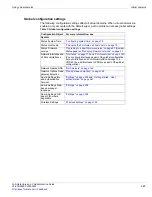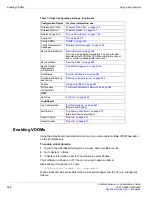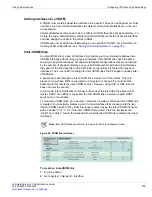
System Network
Interfaces
FortiGate Version 4.0 Administration Guide
01-400-89802-20090424
121
Name
The names of the physical interfaces on your FortiGate unit. This includes any
alias names that have been configured.
The name, including number, of a physical interface depends on the model.
Some names indicate the default function of the interface such as Internal,
External and DMZ. Other names are generic such as port1.
FortiGate models numbered 50 and 60 provide a modem interface. Also
models with a USB port support a connected modem. See
.
The oob/ha interface is the FortiGate-4000 out of band management interface.
You can connect to this interface to manage the FortiGate unit. This interface is
also available as an HA heartbeat interface.
On FortiGate models 300A, 310B, 400A, 500A, 620B, and 800 or higher, if you
combine several interfaces into an aggregate interface, only the aggregate
interface is listed, not the component interfaces. The same is true for
redundant interfaces. See
“Creating an 802.3ad aggregate interface” on
“Creating a redundant interface” on page 128
If you have added VLAN subinterfaces, they also appear in the name list,
below the physical or aggregated interface to which they have been added.
See
.
If you have loopback virtual interfaces configured you will be able to view them.
You can only edit these interfaces in the CLI. For more information on these
interfaces see
“Configuring interfaces with CLI commands” on page 134
or the
config system interface
command in the
.
If you have software switch interfaces configured, you will be able to view
them. You can only edit these interfaces in the CLI. For more information on
these interfaces see
“Configuring interfaces with CLI commands” on page 134
or the
config system switch-interface
command in the
.
If virtual domain configuration is enabled, you can view information only for the
interfaces that are in your current virtual domain, unless you are using the
super admin account.
If VDOMs are enabled, you will be able to create, edit, and view inter-VDOM
links. For more information see
“Inter-VDOM links” on page 113
If you have interface mode enabled on a FortiGate model 100A or 200A
Rev2.0 or higher or on the FortiGate-60B and FortiWiFi-60B models, you will
see multiple internal interfaces. If switch mode is enabled, there will only be
one internal interface. For more information see
.
If your FortiGate unit supports AMC modules and have installed an AMC
module containing interfaces (for example, the FortiGate-ASM-FB4 contains 4
interfaces) these interfaces are added to the interface status display. The
interfaces are named AMC-SW1/1, AMC-DW1/2, and so on. SW1 indicates it
is a single width or double width card respectively in slot 1. The last number “/1”
indicates the interface number on that card - for the ASM-FB4 card there would
be “/1” through “/4”.
IP/Netmask
The current IP address/netmask of the interface.
In VDOM mode, when VDOMs are not all in NAT or Transparent mode some
values may not be available for display and will be displayed as “-” instead.
When IPv6 Support on GUI is enabled, IPv6 addresses may be displayed in
this column.
Access
The administrative access configuration for the interface.
See
“Administrative access to an interface” on page 135
.
Administrative
Status
The administrative status for the interface.
If the administrative status is a green arrow, the interface is up and can accept
network traffic. If the administrative status is a red arrow, the interface is
administratively down and cannot accept traffic. To change the administrative
status, select Bring Down or Bring Up.
Link Status
The status of physical connection.
The status of a non-physical interface will always be down.
MAC
The MAC address of the interface.
Mode
Shows the addressing mode of this interface such as manual, DHCP, or
PPPoE.
MTU
The maximum number of bytes per transmission unit. Anything over 1500 are
jumbo frames. See
Summary of Contents for Gate 60D
Page 705: ...www fortinet com...
Page 706: ...www fortinet com...
































